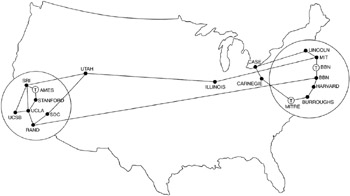14.1 A Brief History of Computer Networks
14.1 A Brief History of Computer Networks
As with the electronic computer, the military spurred the creation of computer networks that have developed into the Internet. In 1969, the Advanced Research Projects Agency (ARPA), a part of the Defense Department, began funding companies and universities to develop a communications system to withstand heavy enemy attacks. The primary aim was to enable military installations around the country to communicate even if significant parts of the communications system were destroyed. However, an early memorandum noted that such a system would have additional benefits.
While highly survivable and reliable communications systems are of primary interest to those in the military concerned with automating command and control functions, the basic notions are also of interest to communications systems planners and designers having need to transmit digital data. (Baran 1964)
By the end of 1969, a primitive network named the ARPANET was in place (Figure 14.1). This network was the foundation of the modern Internet.

Figure 14.1: Map of ARPANET.
In 1991, the World Wide Web (WWW) was released to the general public, making it easier for people to use the Internet. Since then, the Internet has been commercialized and its popularity has grown exponentially. In fact, so many people have been using the Internet that several universities and research organizations decided to set up second, higher speed networks in an effort to bypass the traffic jams on the Internet. One of these high-speed networks is called Abilene.[2]
In a relatively short period, technology has advanced to the point where the lines between computers, televisions, telephones, and print media have been blurred. Many experts in computing and telecommunications agree that, with this seamlessly integrated global infrastructure in place, the next 5 years of computing and telecommunications will bring more changes than the last 20 years. Already, households and neighborhoods are being connected to networks that enable them to operate, communicate, and collaborate more effectively. This technology enables the owner of a house to control household functions remotely. Conversely, this technology could give criminals access to household appliances. The day approaches when someone from across the world can stage an accident by turning on a gas stove and sparking a toaster to blow up another's house.

Figure 14.2: Time line of key events.
[2]http://abilene.internet2.edu
EAN: 2147483647
Pages: 279